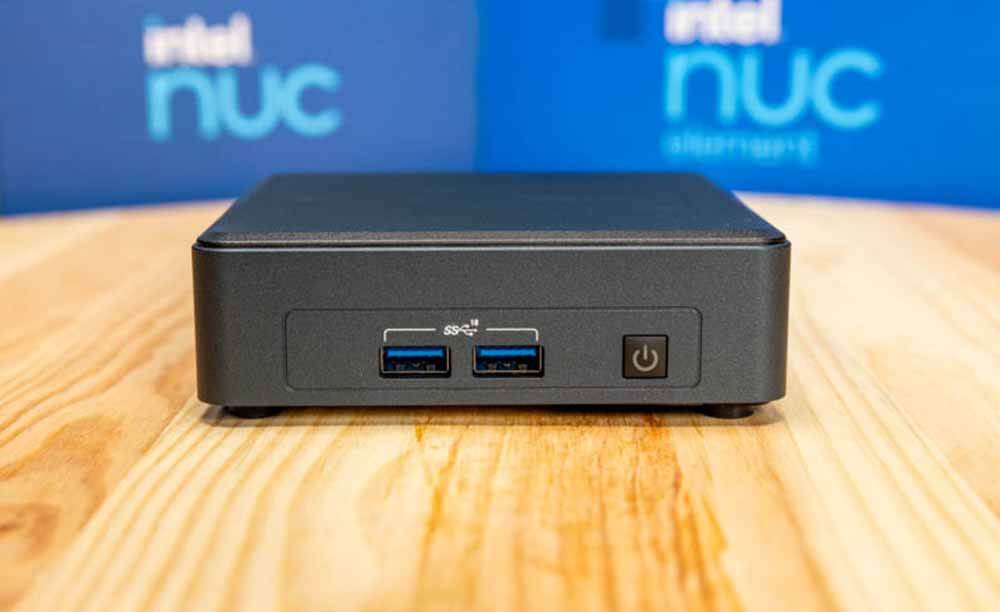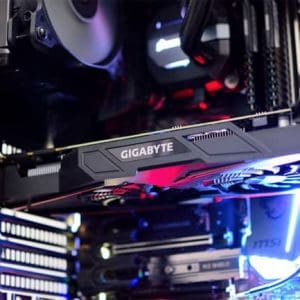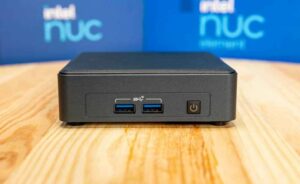Intel’s Next Unit of Computing (NUC) mini-PCs has been around for a while, allowing the company to demonstrate how much speed and capability can be packed into a small, simple desktop design. This is excellently demonstrated by the Intel NUC 11 Pro-Kit NUC11TNKi5, which is based on Intel’s “Tiger Canyon” mini-PC platform and “Tiger Lake” mobile CPUs.
The NUC11TNKi5 is a little yet powerful computer that packs the power of a PC many times its size into a palm-sized miniature. While small PCs have generally attracted extremely specialized clients and limited use cases, kits like this are beginning to change the narrative on account of power and computing efficiency as well as space-saving features.
The NUC 11 Pro excels in its position (and its small chassis) as a laptop for everyday work and browsing, despite its gaming performance being predictable (albeit better than previous models owing to the new Iris Xe integrated technology). It’s one of the greatest traditional-size small-form-factor (SFF) PCs on the market today, in my opinion.
Connect and Power the Future
The NUC11TNKi5 packs a surprising amount of connectivity possibilities crammed into its compact chassis despite its “portability over power” design objective.
For digital signage, video conferencing, and other applications, the NUC11TNKi5 i5-1135G7 CPU with Intel® Iris® Xe graphics may handle one 8K or four 4K monitors distributed on the two HDMI outputs and two Thunderbolts. It can handle up to four screens in various ways according to compatible ports.
Use the Dual 2.5Gb Ethernet to run Tiger Canyon in a cluster of tiny form factor PCs or to generate network redundancy.

What’s more, the NUC11TNKi5 has 6 external and 8 total USB connection ports with one Thunderbolt 4 and One Thunderbolt 3 port. Right up front, you have a pair of USB 3.2 ports and at the back end another USB 3.2 (type A connector), a pair of USB4 (Type–C) ports, and a USB 2.0 (type A) port. One of the USB4 ports supports thunderbolt 4 and the other Thunderbolt 3. But that is not all there is to USB interfaces on this platform! They also saw it fit to include two more; a USB 3.2 on M.2 and USB 2.0 headers in the little tiger’s belly (machine internals). The utmost benefit of USB 3.2 is its extremely-fast downloading and uploading speeds.
With the newest wired and wireless choices, Intel® Wi-Fi 6 AX201; the fastest generation of Wi-Fi-capable of 2.4GBps; and two ultra-fast Thunderbolt connections; businesses can get more work done anytime, anywhere. Chips that enable interoperability with the Wi-Fi 6 AX201 standard, as well as Bluetooth 5.0, may be found next to the front USB ports and beneath the case cover.
You May Like: INTEL NUC Mini Computer: Your Best Travel computer
Reliable Business-Class Remote Manageable Computing
Tiger Canyon, which is based on Intel’s 11th Generation architecture, offers improved system performance over prior generations and is comparable to the newest Intel NUC Studio 12 Pro, which features sophisticated hyperthreading capabilities for quicker speeds and improved graphics. Intel NUC 11 Pro Mini PCs, kits, and boards are tiny, powerful systems built for today’s specifications—and keep businesses powered for many months to come. They’re qualified for 24×7 operation and come with a three-year guarantee.
You can help your clients stay ahead of security risks by using Intel® vProTM technology. Keep client data and credentials private thanks to the built-in hardware-enhanced security, and remote management is ideal for installations like unattended digital kiosks and intelligent vending.
A single 64-bit quad-core performance x64 microprocessor (Intel Core i5-1135G7 CPU), which was previously known as Tiger Lake, translates to increased productivity and efficiency. It incorporates 10nm SuperFin lithography and 8MB cache with a nominal speed of 2.6Ghz without the turbo boost which churns a top 4.4GHz. Intel Xe Graphics are built into the CPU and run at a nominal 300 MHz and burst at 1.35GHz. This is the GPU that makes two 4K or one 8K screens possible at 60FPS.
It’s a special machine that has an inbuilt Xe iGPU in the CPU, which implies the TPD and RAM are shared between the two. The thermal design power TDP is rated 28W and couples with dual-channel DDR4-3200 RAM, improving the interleaving design to result in better multitasking.
| Pros | Cons |
|
|
Start Light, Upscale at Will
The 11th Gen Intel Core processors are the first to feature Intel® Iris® Xe graphics and are divided into four categories: Pro (Tiger Canyon), Enthusiast (Phantom Canyon), Compute Element (Elk Bay), and Performance (Panther Canyon). Each of these categories is distinct and developed for a certain user; for example, the Compute Element was created with light gaming, home entertainment, and content production in mind.
On the other hand, the Intel® NUC 11 Pro unit, which we are analyzing in this post, in particular the mid-range NUC11TNKi5 — with an i5-1135G7 Processor (8M Cache, up to 4.20 GHz) retailing at $484.38 for a barebones model — was built for edge computing, as well as home and office use.
Other models of the NUC 11 Pro-Kit include the NUC11TNKi7 — with an i7-1185G7 Processor (12M Cache, up to 4.80 GHz, with IPU) — starting at $679.00 (bare) and the NUC11TNKi3 — with an i3-1115G4 Processor (6M Cache, up to 4.10 GHz) — costing $361.99 (bare).
What Is a Barebones Model?
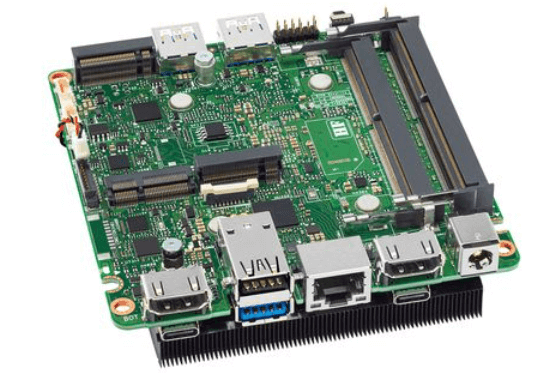
A barebones computer/hardware is a framework or package that includes everything you need to get started (or partially assembled and in need of additional hardware) to make a custom PC. The NUC 11 Pro barebones computers are cheaper than retail computer systems unless you choose expensive customization.
Manufacturers or individual computer builders, who are computer hardware enthusiasts or run full-fledged home enterprises, can build, use, and sell this powerful mini-PCs from parts ordered from makers such as Intel. The following items are commonly seen in these barebones computers:
- Motherboard
- Optical drive
- Cooling apparatus
- Power supply
Every Intel NUC 11 Pro barebones model comes with a media card reader or a hard drive, and in our case, the NUC11TNKi5 has an M.2 SSD (solid-state drive) internal disk form format for mounting storage expansion cards. Unless you choose a preconfigured model from a third-party seller, the base kit version of this PC will need you to purchase and install components, such as the memory/RAM and adapters, yourself.
Installing the different bits is simple to accomplish, though. You will have access to the interior by removing four screws from the bottom. The system supports two different types of storage disks. SATA or PCI Express NVMe SSDs, as well as Intel Optane Memory modules, will fit in the M.2 slot on the mainboard. Alternatively, you may use the “NVMe Only” slot on the PCB to attach an NVMe SSD. More standard 80mm-long (Type-2280) drives can be used in the “NVMe Only” M.2 slot.
The preconfigured Intel NUC 11 Pro model we’re looking at today costs $995.06 and includes 16 GB of RAM, a 512GB M.2-based SATA SSD, a Core i5-1135G7 CPU (a 4-core, 8-thread 11th Gen CPU) with integrated Iris Xe Graphics GPU (base and boost clock speeds of 2.4GHz and 4.2GHz), and Windows 10 Pro. The PC offers an excellent connection, including six USB ports, two HDMI ports, WiFi, and a 2.5Gb wired ethernet port. That type of power is generally more than enough to get users where they want to go without slowing them down for the duties that this kind of machine is designed to do.
If you want to buy this exact model, you will have to consider costs like $119 for Windows 10 Home or $199 for a Pro license, and around $80 for the SO-DIMM RAM piled on top of the $$484.38 base price. The 3,200MHz SO-DIMM DDR4 memory (in this example, as a single module) is clocked, but the system can accommodate up to 64GB if you add more RAM later.
Intel NUC 11 Pro-Kit Specifications
Below are specifications for the $484.38 Intel NUC 11 Pro-Kit (NUC11TNKi5, ‘Tiger Canyon’) bare model that we will be reviewing:
| Supported OSes: | 64-bit, Windows 10, Windows 10 IoT Enterprise, Ubuntu 20.04 LTS, and Red Hat Linux | CPU: | 11th Gen Intel Core i5-1135G7 Processor (8M Cache, up to 4.20 GHz)
Embedded GPU: Intel Iris Xe Graphics (Up to 1.35 GHz, and 96 EUs) IPU (Image Processing Unit) |
| Memory (RAM): | 16 GB Installed (64 GB Maximum) 2 x DDR4-3200 1.2V SO-DIMMs | Internal Storage Options: | 1x M.2 2242 SATA III/PCIe Gen 3 (Populated with a 512GB TS512GMTS430S)
1x M.2 2280 PCIe Generation 4 X4 NVMe |
| Display: | 2x DP 1.4a and USB 4 Through Thunderbolt
2x HDMI 2.0b1x HDMI – Passthrough Max Resolution HDMI 4096×2304 at 60Hz Max Resolution DP 7680×4320 at 60Hz |
Compliance Standards: | The Machine Meets Several Safety Regulations, Electromagnetic Compatibility (EMC) and Radio Frequency (RF), and Environmental Standards |
| Ports: | 1 x Thunderbolt 3 Port
1 x Thunderbolt 4 Port 1 x USB 2.0 Type A 3 x USB 3.2 Gen 2 Type A |
Multimedia: | 3.5mm Stereo-In Jack |
| Power Consumption: | 19V, 6.32A, 120W External AC-DC Power Supply | Dimensions: | 112 x 117 x 37mm |
| Network Connectivity: | 2.5Gb via Intel Ethernet Controller i225-LM
Intel Wi-Fi 6 AX201 802.11ax (2.4Gbps Supports/802.11a/b/g/n/AC/ax) Bluetooth v5.1 |
Color: | Black |
| Warranty: | 3 Years | Package Contents: | NUC 11 Device, VESA Mounting Plate, Power Adapter, and Numerous User Guides |
Comparing Tiger Canyon with Bespoke Models: Keeping with Up Clock Rates!
The midrange NUC11TNKi5 is impossible to compare to many other mini-PCs on a 1:1 ratio. But here are the closest systems in the stable that we could find. Some of these options are barebones, while others are fully loaded PCs.
Intel NUC 11 Pro vs. Intel NUC 10 Pro vs. Intel NUC 12 Studio Pro
Because these NUCs were built for comparable use cases, Intel’s NUC 11 Pro is almost certainly compared to its predecessor, the NUC 10 Pro. Both CPUs contain the same Intel Iris Xe Graphics (96 Execution Units) IGPU, Intel Wi-Fi 6 AX, and 4 cores/8 threads. However, the clock speeds are somewhat different: 3.0GHz up to 4.8GHz MAX TDP 28W for the 10 Pro and 2.6GHz up to 4.4GHz MAX TDP 28W for the 11 Pro.
Intel’s next-generation NUC mini-PCs continue to dominate the market, with the newest release being the Intel NUC Studio 12 Pro, codenamed ‘Wall Street Canyon.’ With numerous upgrade options and Intel Alder Lake-P processors — the least powerful of which is powered by a dual-core Intel Core i3-1220 processor, and the most powerful of which is powered by a quad-core Intel Core i7-1270 processor — the ‘Wall Street Canyon’ is likely to draw comparisons with the Apple Mac Studio.
Preliminary results show that the new CPU allows the NUC Studio 12 Pro to achieve 692 points in the Cinebench R20 single-core test and 4,055 points in the multi-core test. In both tests, the Core i7-1165G7, which is offered in the NUC 11 Pro, scores 564 and 1,987 points, respectively.
With dimensions of 116.84 x 111.76 mm, the NUC 12 Studio Pro is significantly smaller than the Mac Studio. The NUC 12 Studio Pro will be available in small and tall configurations, with the latter containing a 2.5cm drive port, just like previous NUC models. The NUC11TNKi5 with the 1.5cm casing and an i5-1135G7 CPU is the device we’re looking at in this post.
The NUC 11 Pro has a front-to-back measurement of 4.6 inches, a width of 4.4 inches, and a height of 1.45 inches. With the accompanying VESA mount, you may attach it to a wall or the underside of a desk, decreasing the footprint as much as possible.
Intel NUC 11 Pro vs. Intel NUC 9 Extreme Kit vs. Intel NUC Compute Element
The NUC 9 Extreme Kit, for example, is a bigger, one-of-a-kind small-form-factor (SFF) device that uses Intel’s Compute Element modular core component solution. It’s a whole different beast from the model.
Keep in mind that depending on the SSD and RAM you install in the NUC Pro 11, your performance mileage may vary.
PCMark 10 Test (The Higher the Score, The Better)
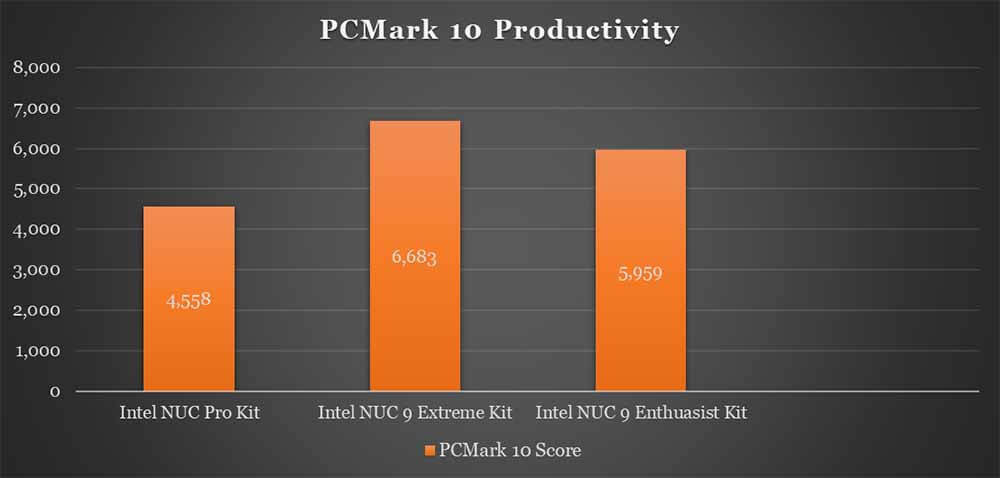
PCMark 10, my first performance test, is a comprehensive performance suite designed by UL’s benchmark experts (formerly Futuremark). It’s used by the majority of IT organizations to evaluate overall system performance for office-related operations including word processing, spreadsheet work, web surfing, and videoconferencing. The test provides a numerical score; the greater the number, the better.
Again, it’s impossible to avoid apples-to-oranges comparisons in any of these tests, but the NUC 11 Pro comfortably surpassed the 4,000-point level, demonstrating good overall productivity. It’s more than capable of handling most Microsoft Office, video-calling, and web-browsing activities you throw at it.
Maxon’s CPU-intensive Cinebench R15 Test (The Higher the Score, The Better)
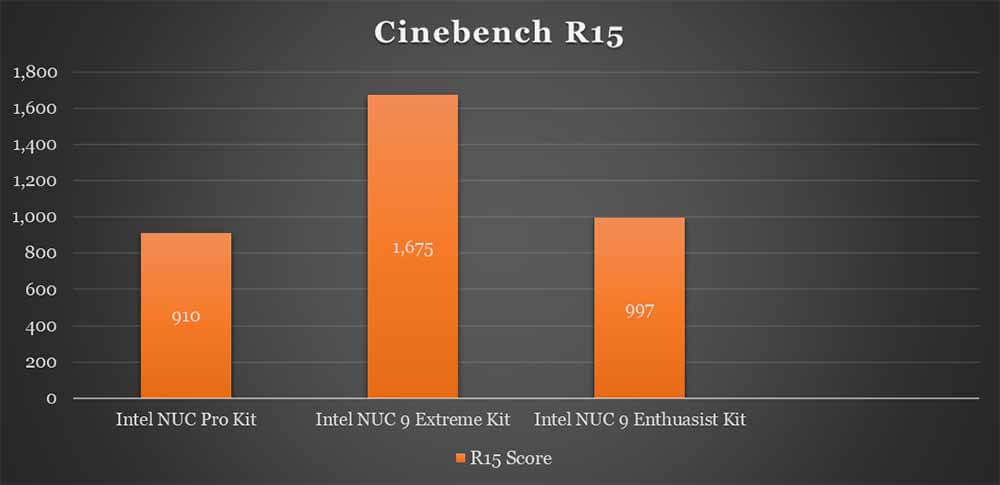
The next test is Maxon’s CPU-intensive Cinebench R15, which is fully threaded to utilize all processor cores and threads. To render a complicated image, Cinebench uses the CPU rather than the GPU. The result is a proprietary score that indicates a PC’s readiness for multi-threaded, processor-intensive applications.
You’re doing it incorrectly if you’re transcoding massive video files on a NUC. Although this isn’t a content-creation workstation and doesn’t function as one, I won’t penalize it for scoring in the middle of the pack in this category of testing. It holds its own, and the NUC 9 Extreme is in a league of its own once more (and far, far pricier).
Handbrake Test (The Lower the Minutes, The Better)
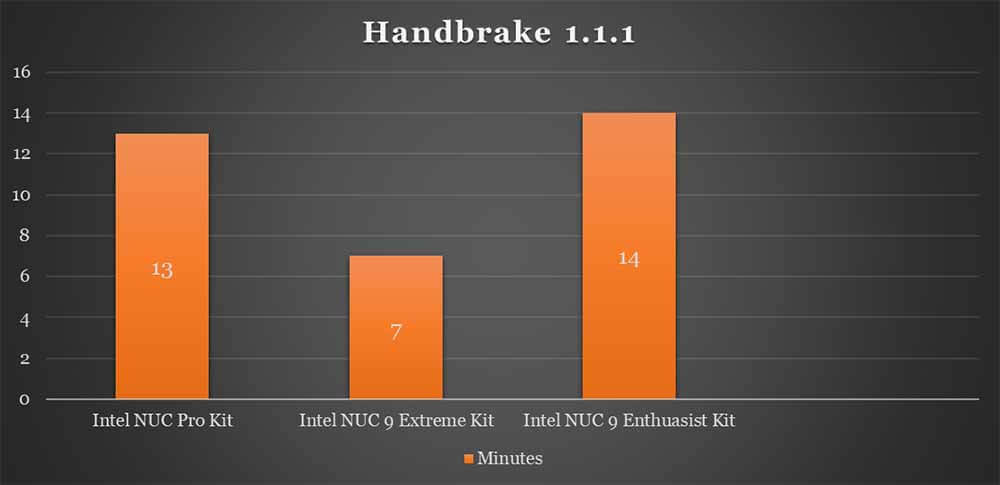
The NUC 11 Pro stayed competitive with most of the other options we’ve tested, and did surprisingly well against the NUC 11 Enthusiast Kit in our Handbrake test, which measures how quickly (or not, in the case of mini-PCs like the MSI Cubi 5 10M) a system can transcode a video file from one resolution to another.
SPECworkstation 3 Test
SPEC workstation 3 is a customized test that uses over 30 workloads to assess CPU, graphics, I/O, and memory bandwidth to benchmark critical areas of workstation performance. The study revealed that the NUC 11 Pro was slower than the NUC 9 Pro and NUC 10 Pro systems, but comparable to the NUC 8 system. The NUC 9 Pro system, with its 8-core Xeon CPU E-2286M and discrete GPU, outperformed the NUC 11 Pro by around a factor of two.
Custom Adobe Photoshop Image-Editing Benchmark Test (The Lower the Seconds, The Better)
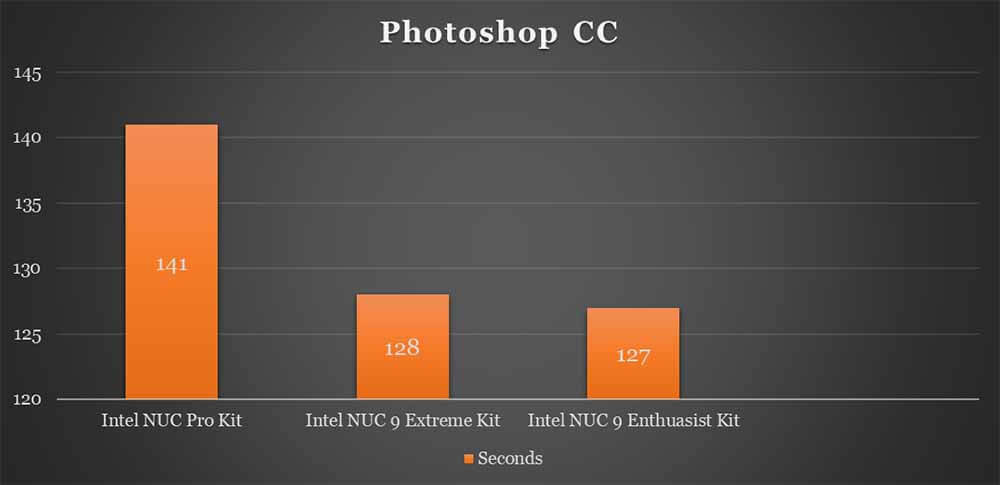
Lower times, like with the Handbrake test, are preferred here. Although the Photoshop test puts a load on the CPU, storage subsystem, and RAM, it can also utilize most GPUs to speed up the filter application process, so systems with powerful graphics chips or cards may see a performance boost.
Using an early 2018 iteration of the Creative Cloud version of Photoshop, I applied a sequence of 10 sophisticated filters and effects to a regular JPEG test image, timing each operation and adding up the total. The result was that the NUC 11 Pro-Kit beat the much beefier (and nearly twice as expensive) NUC 11 Enthusiast Kit. Let’s get this party started, little guy!
3DMark Graphics Test
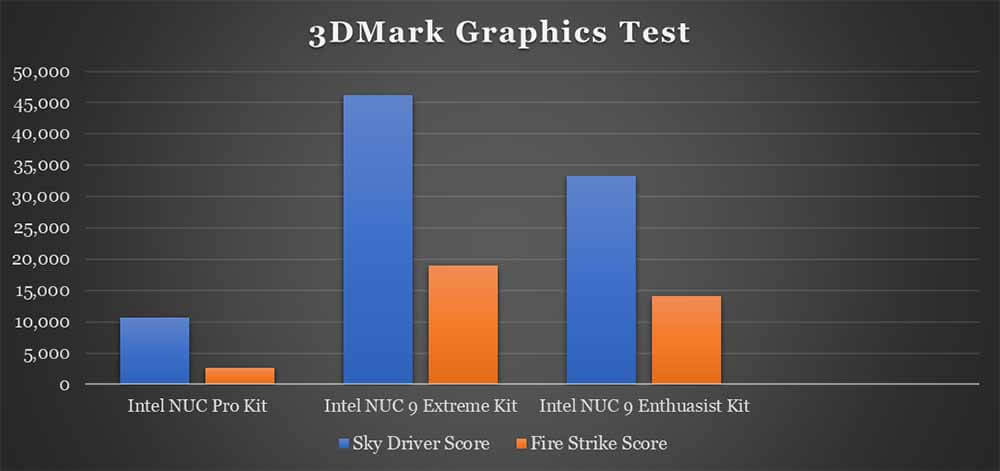
The NUC11TNKi5 features Iris Xe integrated graphics. So, I put the Intel NUC 11 Pro through a variety of synthetic graphics tests, including 3DMark’s integrated-graphics-friendly SkyDiver and more challenging Fire Strike benchmarks, as well as the UNIGINE Superposition gaming simulation, to assess graphics performance.
The system’s Iris Xe graphics worked as expected in these tests, but they were nowhere near as well as more powerful options with dedicated GPUs, like the GeForce RTX 2060-equipped NUC 11 Enthusiast. If you’re looking for a small-form-factor PC that can handle gaming, the NUC11TNKi5 isn’t the ideal choice. The Radeon Vega 11 integrated graphics processor (IGP) in Asrock’s Ryzen 5-based DeskMini X300 outperforms it as well.
However, this is a better attempt than previous NUCs based on Intel’s notoriously sluggish IGPs. Compare the graphics capabilities of the NUC 11 Pro to those of the Lenovo and MSI minis, which use Intel UHD 630 and 620 Graphics, which are the successors of the Iris Xe IGP generation. Intel’s integrated graphics processors are improving, but they’ll never be mistaken for standalone GeForce GTX or RTX chips.
Verdict: Intel Still Got IT!
While the Intel NUC 11 Pro-Kit (NUC11TNKi5, ‘Tiger Canyon’) doesn’t provide anything groundbreaking, it does focus on refinement, which we welcome. It’s an aggressively priced entrance into a tiny but essential market for both commercial and professional clients, whether you’re wanting to power some digital signage or just want a decently zippy desktop that takes up nearly little workspace.
True, it’s not the graphics powerhouse and gaming machine that the NUC 11 Enthusiast Kit just demonstrated. But, given its smaller size and lower price, I applaud it for cramming in as much performance as it can, particularly for weekday productivity and extreme multi-display applications.
Consider NUC11TNKi5 shining illustration of what Intel is currently doing well in the mobile and SFF PC markets. While it may be losing ground to AMD in high-performance desktops at the moment, it’s encouraging to see Intel focusing on areas where it can still win.
About the author: Michael Parrotte was the Vice President of AGV Helmets America, and a consultant for KBC Helmets, Vemar Helmets, Suomy Helmets, Marushin Helmets, KYT Helmets, and Sparx Helmets. In addition, he is the founder and owner of AGV Sports Group.
M/A

